How to Streamline Content Review and Approval — Best Practices, Tools & Automation
12 May
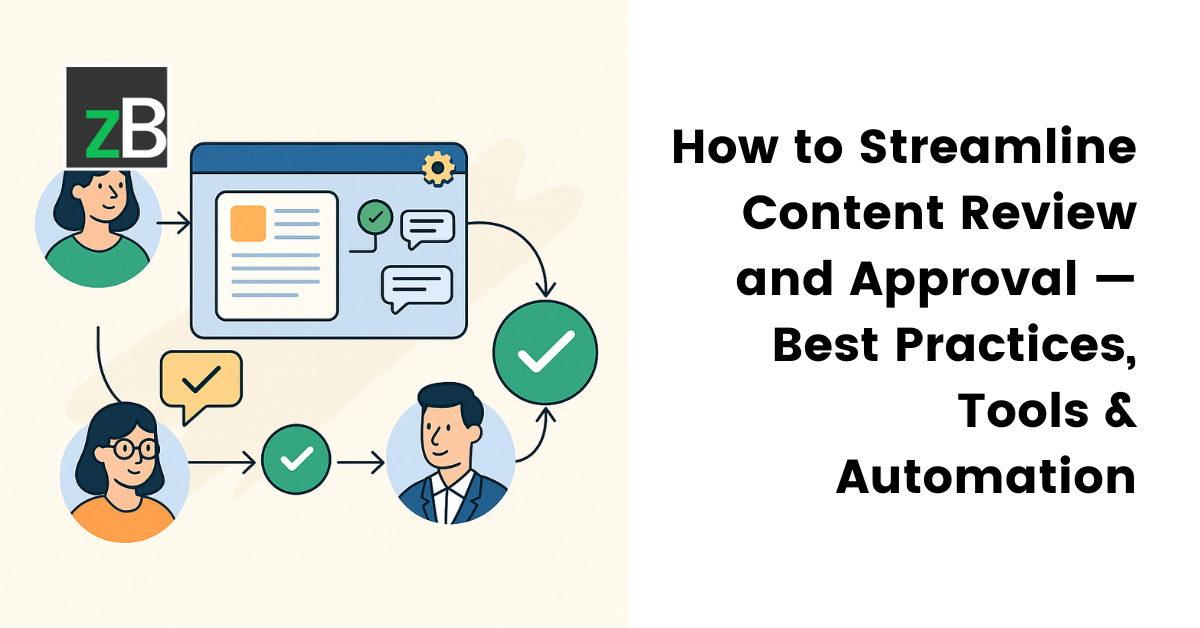
Table of Contents
ToggleContent review and approval is a critical process across industries. From marketing teams ensuring brand consistency, to eLearning developers refining course content, product teams maintaining accurate documentation, and UX designers perfecting user experiences.
But as content creation scales, so do the challenges, especially when external stakeholders, such as clients, subject matter experts (SMEs), and vendors, are involved.
Miscommunication is a costly problem. According to the 2023 State of Business Communication report by Grammarly, it costs US businesses an average of $12,506 per employee each year.
This highlights the countless hours teams waste each week trying to manage feedback scattered across email threads, chat apps, and shared documents, leading to missed deadlines, version confusion, and frustrated stakeholders.
But it doesn’t have to be this way. With a streamlined content review and approval process, you can eliminate these headaches, enhance collaboration, and accelerate approvals.
This guide will show you how to optimize your content review and approval workflow—from best practices and essential tools to automation techniques that save time and reduce errors.
TL;DR | Key Takeaways
- The content review and approval process ensures quality, consistency, and compliance before publishing.
- Modern teams struggle with feedback chaos, version confusion, and delays, especially when external collaborators are involved.
- Streamlining the process with centralized tools improves speed, accuracy, and stakeholder alignment.
- Automation, clear workflows, and real-time collaboration reduce manual effort and missed deadlines.
- Organizations implementing structured review processes see up to 50% faster approvals and up to 50% fewer revision cycles.
- Platforms like zipBoard help manage external stakeholder reviews seamlessly, without requiring logins.
What is the Content Review and Approval Process?
Lorem ipsum dolor sit amet, consectetur adipiscing elit. Ut elit tellus, luctus nec ullamcorper mattis, pulvinar dapibus leo.
The content review and approval process is a systematic workflow that ensures content is accurate, consistent, compliant, and aligned with brand guidelines before it is published.
This process involves multiple stakeholders, such as content creators, subject matter experts (SMEs), clients, and approvers, who review and provide feedback on the content to ensure it meets quality standards.
Difference Between Review and Approval
The review stage is where stakeholders examine content for accuracy, clarity, design, and adherence to guidelines. Reviewers provide feedback, request changes, and suggest improvements.
On the other hand, the approval stage is the final stage where authorized stakeholders formally confirm that the content is complete, accurate, and ready for publication.
Typical Stages of the Content Review and Approval Process
- Drafting: Content is created by authors or designers.
- Reviewing: Reviewers assess the content and provide feedback.
- Revisions: Content is updated based on feedback received.
- Approval: Designated approvers formally approve the final version.
- Publishing: Approved content is published across relevant channels.
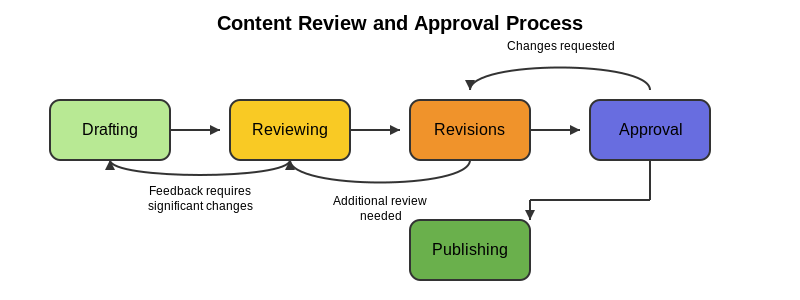
Why Do Content Reviews and Approvals Matter?
Effective content review and approval processes are essential for maintaining quality, compliance, and brand consistency across all types of content—whether it’s marketing collateral, eLearning modules, product documentation, UX designs, or internal communications. Here’s why they matter:
- Quality Assurance and Error Prevention: A structured review process helps catch and correct errors before content goes live, ensuring accuracy and clarity. Teams can identify spelling mistakes, factual inaccuracies, design flaws, or broken links that could otherwise harm user experience.
- Brand Consistency Maintenance: Regular reviews ensure that all content aligns with brand guidelines, tone of voice, and visual style. This is crucial for maintaining a consistent brand identity across multiple channels.
- Regulatory Compliance and Risk Management: For industries with strict compliance requirements, such as healthcare, finance, or education, content reviews help verify that materials meet legal and regulatory standards, reducing the risk of non-compliance penalties.
- Stakeholder Alignment and Buy-In: Reviewing and approving content with input from key stakeholders (internal teams, clients, or external partners) ensures everyone is aligned. This avoids misunderstandings, minimizes disputes, and fosters better collaboration.
- Evidence-Based Results: Organizations that implement structured content review processes see measurable improvements. For example, Companies like ELM Learning saved their creative team up to 5000 hours annually using a well-defined, unified client feedback and QA process in zipBoard. Learn more here →
Common Challenges in the Content Review and Approval Process — Especially with External Stakeholders
Content review and approval can be a smooth, efficient process—until external stakeholders are involved. At this point, teams often face a range of challenges that slow down progress and increase frustration. Here are the most common challenges:
- Feedback Chaos Across Multiple Channels: Teams often collect feedback through email, Slack, Google Docs, and other channels, leading to scattered, inconsistent feedback. This chaos makes it difficult to consolidate input, track changes, or ensure all feedback is considered.
- Missed Deadlines and Version Confusion: Without a clear workflow, reviewers may miss deadlines or review outdated versions of content. This results in wasted time, duplicated work, and a higher risk of errors. In fact, a study by Grammarly found that poor communication can cost companies an average of $12,506 per employee each year due to lost productivity.
- Miscommunication and Rework: Vague or unclear feedback leads to misunderstandings. Teams may spend hours revising content based on incomplete comments, only to realize they misunderstood stakeholder expectations. This can result in a never-ending cycle of revisions.
- Lack of Transparency and Status Tracking: When using disconnected tools, stakeholders often have no visibility into the content’s review status. Is it under review? Who needs to approve it next? This lack of clarity leads to confusion and delays.
- Inconsistent Review Workflows: Different teams may follow different review processes, making it hard to standardize quality or ensure compliance. This is especially problematic for organizations with cross-functional or remote teams.
- Challenges with External Collaborators: When clients, partners, or vendors are involved, review complexity increases. External stakeholders may not have access to the same tools, may provide feedback in different formats, or may struggle with platform logins.
- Remote Team Coordination Issues: Working with global teams means dealing with time zone differences, cultural expectations, and communication barriers. Delays in feedback or approvals become almost inevitable.
- Cost of Delays: Every day of delay in content approval can lead to lost opportunities.
Overcome These Content Review & Approval Challenges with zipBoard
With zipBoard, teams can centralize feedback, ensure clear review workflows, and provide external stakeholders with a simple, no-login-required review experience—transforming a chaotic process into a streamlined workflow.
Book DemoStart Free TrialIndustry-Specific Challenges in Content Review and Approval
While content review and approval are critical across all industries, the challenges can vary significantly depending on the type of content, stakeholders involved, and industry standards. Here’s a look at some of the unique review challenges faced by different industries:
- Rapid Turnaround Needs: Marketing teams must quickly produce, review, and publish content for multiple channels—social media, email, blogs, ads—without compromising on quality.
- Multi-Channel Content Consistency: Ensuring consistent messaging and branding across platforms is crucial but challenging without a clear review workflow.
- Brand Consistency: Reviewers must ensure that all content aligns with brand guidelines, tone, and voice, which can be difficult with multiple reviewers.
Recommended Reading: How a content review process helps your marketing strategy
- SME (Subject Matter Expert) Availability: Getting timely feedback from busy SMEs can slow down the review process.
- Technical Accuracy and Accessibility: Content must be technically accurate, compliant with learning standards (SCORM, xAPI), and accessible to all learners, adding complexity to reviews.
- Interactive Content Review: Complex, interactive content requires reviewers to assess functionality, not just text or visuals.
Recommended Reading: Content Review & Issue Tracking Best Practices
- Technical Documentation: Content must be precise and technically accurate to avoid misleading users.
- Feature Alignment: Content must accurately reflect product features and updates, which can change rapidly.
- Internationalization: Reviewing multilingual content for global markets introduces another layer of complexity.
Recommended Reading: Technical Document Review Process: Guide for Faster Project Completion
- Visual Feedback and Annotations: Design and UI/UX content require clear, precise feedback on visual elements, layouts, and user interactions.
- Iterative Review Cycles: Design teams often follow an iterative process, making it essential to track changes and feedback effectively.
- Contextual Understanding: Reviewers need to understand the design context (web, mobile, app) to provide relevant feedback.
Recommended Readings:
- Legal Review Bottlenecks: Content must be reviewed for compliance with regulations (GDPR, HIPAA, CCPA), which often adds a layer of legal review.
- Audit Trails: Teams must maintain detailed records of who reviewed and approved each piece of content.
- Regulated Content: Certain content types (legal documents, medical information) require approval from specific stakeholders or departments.
💡 No matter your industry, zipBoard provides a centralized review platform with customizable workflows, visual feedback tools, and secure guest access for external stakeholders—ensuring that content is reviewed efficiently without unnecessary delays. Try zipBoard for Free Today →
Why Streamlining Content Review and Approval is Crucial
- Faster Time to Market: When reviews are well-organized, content moves smoothly from creation to publication
- Reduced Rework and Miscommunication: Inefficient review processes often lead to conflicting feedback, miscommunication, and endless revision cycles. Streamlining reviews ensures clarity, minimizes errors, and prevents redundant changes.
- Time Savings Through Automation: Manual review coordination—sending emails, tracking feedback, and following up with stakeholders—can be time-consuming. A Box/IDC report revealed that automated approval workflows save teams an average of 3-5 hours per week, freeing them to focus on creative work.
- Consistency and Quality Control: A structured review process ensures that every piece of content meets brand guidelines, compliance requirements, and quality standards.
- Enhanced Stakeholder Collaboration: Streamlining the process makes it easier for internal and external stakeholders to provide feedback without confusion.
💡Centralized content review tools, clear workflows, and automated notifications ensure that feedback is received, reviewed, and acted upon efficiently.
Ready to Speed up Your Content Reviews with A Centralized Platform?
Try zipBoard’s content review and approval solution for free and experience the speed and simplicity of modern content review and approval. Start your free trial of zipBoard today. No credit card required.
Book DemoStart Free TrialBest Practices for Streamlining Content Review and Approval
A streamlined content review process requires the right tools, well-defined workflows, and clear responsibilities. Here are the essential practices to optimize your content approval workflow:
1. Establish Clear Roles and Responsibilities
Clearly distinguish between reviewers (providing feedback) and approvers (giving final sign-off). Define permissions based on these roles to ensure the right people are involved at each stage, keeping feedback focused and actionable.
2. Centralize Feedback in One Platform
Use a dedicated content review platform like zipBoard that supports multiple content types (documents, images, videos, web pages). Avoid scattered feedback across emails, chat apps, and documents by keeping all comments, annotations, and approvals in one accessible location.
3. Define Clear Workflows with Deadlines
Establish structured review phases (draft, review, final approval) with firm deadlines to prevent endless feedback loops. Set automated notifications and reminders to ensure reviewers complete their tasks on time.
4. Implement Version Control and Audit Trails
Maintain clear version history to prevent confusion between drafts and ensure everyone reviews the most current content. Keep a comprehensive audit trail of all edits, comments, and approvals for transparency and accountability.
💡 Look for tools with built-in version control systems to automate this process and save significant time managing document versions.
5. Create Review Templates for Different Content Types
Develop standardized templates for various content types (blog posts, product sheets, eLearning courses) with appropriate review criteria. These templates save setup time and ensure consistent review processes across projects.
6. Enable Contextual Collaboration Features
Choose tools that allow reviewers to leave comments directly on content with visual annotations, text highlighting, and pinned comments. For videos, ensure frame-by-frame commenting capability is available.
7. Onboard All Stakeholders with Clear Guidelines
Whether working with internal teams or external clients, provide comprehensive onboarding with clear instructions on submitting feedback, meeting deadlines, and using the review platform. Test the process with key stakeholders before full implementation to identify and address potential bottlenecks.
[Free Calculator]
Calculate Your Time Savings with Our eLearning Content Development Calculator
Grab your free copy to plan your content development budget, reduce guesswork, and stay on track
DownloadLooking for a Centralized Platform to Manage Your Content Reviews and Approvals?
Try zipBoard free and experience faster, more efficient content collaboration with your team and external stakeholders.
Book DemoStart Free TrialCase Study: How ELM Learning Cut Review Time by 50% with zipBoard
About ELM Learning
ELM Learning is a leading eLearning design agency known for creating high-quality, interactive training scenarios for global tech giants like Microsoft, Facebook, and Apple.
With a team of designers, developers, and learning experience designers, ELM Learning specializes in delivering custom eLearning solutions that require continuous collaboration with clients and stakeholders.
The Challenge: Content Review Bottlenecks
Despite their expertise in creating world-class eLearning content, ELM Learning faced significant challenges in their content review and approval process:
- Disorganized Feedback: Feedback came from multiple channels (emails, documents, chat apps), making it difficult to consolidate.
- Missed Deadlines: The team struggled with managing client feedback and keeping up with review timelines.
- Version Confusion: Stakeholders often provided feedback on outdated versions of content, leading to rework.
- Approval Delays: With no clear review workflows, reviews often stalled, delaying project completion.
The Solution: A Streamlined Approach with zipBoard
To overcome these challenges, ELM Learning adopted zipBoard, a centralized platform designed for content review and collaboration. With zipBoard, they transformed their review process in the following ways:
- Centralized Feedback: All client and internal feedback was consolidated in one platform, ensuring nothing was missed.
- Clear Workflows: ELM Learning set up customized workflows in zipBoard with clear phases, including project setup, internal collaboration, client review, and QA.
- Visual Feedback: Clients and internal teams could leave comments directly on content (images, PDFs, videos) for better context.
- Seamless Client Access: Clients could provide feedback without needing an account, speeding up review cycles.
- Automated Notifications: The team received reminders for pending tasks, ensuring that deadlines were met.
Measurable Results
After integrating zipBoard, ELM Learning achieved remarkable improvements:
- 50% Reduction in Review Cycle Time: Review cycles were cut in half, allowing the team to meet tighter deadlines.
- 5,000 Hours Saved Annually: The creative team saved approximately 2 hours per person per day on redundant tasks, such as switching between apps.
- Enhanced Content Quality: Centralized feedback improved content accuracy, ensuring that client expectations were consistently met.
- Streamlined QA Process: Tasks and bugs were managed within zipBoard, making it easy to track, prioritize, and resolve issues.
Key Lessons Learned
- Unified Platform Boosts Efficiency: Centralizing feedback in zipBoard reduced confusion and saved time.
- Clear Workflows Ensure Accountability: Defining review stages and responsibilities minimized missed tasks.
- Visual Context Enhances Collaboration: Annotating directly on content made it easier for clients and team members to communicate.
Implementing zipBoard into our development process has transformed the way we handle client feedback and QA. The team is more efficient, and our clients are happier because they can give feedback directly in the platform.
— Beth Epperson, QA Manager & Accessibility SME, ELM Learning
Before vs. After
Watch the full case study video below:
How to Onboard External Stakeholders to Your Review Process
Onboarding external stakeholders (clients, SMEs, vendors) is key to smooth collaboration. Follow these steps for effective onboarding:
- Provide Clear Instructions: Share a simple, step-by-step guide on how to access content, leave feedback, and track changes.
- Set Expectations Upfront: Clarify the feedback format (comments, annotations), focus areas, and deadlines.
- Show Examples of Helpful Feedback: Guide stakeholders on giving actionable feedback (e.g., “Clarify this point” vs. “This is unclear”).
- Share Quick Training Resources: Offer a short tutorial or guide (video or PDF) for using the review tool efficiently.
- Highlight the Benefits of Your Process: Emphasize faster feedback cycles, clearer communication, and better content quality.
These steps ensure external reviewers contribute effectively without confusion or delays.
Security and Compliance in the Content Review Process
Securing your content review process is critical, especially when handling sensitive information. Here’s how to maintain security and compliance:
- Permission Settings and Access Control: Implement role-based access control (RBAC) to ensure only authorized individuals can access, comment on, or edit content. Granular permissions protect sensitive materials while enabling necessary collaboration.
- Audit Trails for Accountability: Maintain chronological records of all content changes—tracking who made changes, when, and what was modified. These audit trails help meet regulatory requirements and provide evidence during compliance reviews.
- Secure External Collaboration: When sharing with external stakeholders, use encryption, password protection, and two-factor authentication. Ensure all external reviewers understand your security protocols to prevent breaches.
- Compliance Considerations: Align your review processes with relevant regulations like HIPAA (healthcare), GDPR (personal data), or industry-specific standards. Your review platform should support these compliance requirements with appropriate security features.
A secure, compliant review process protects your organization while maintaining efficient collaboration.
How to Choose the Right Content Review and Approval Software
(For Teams Collaborating with Clients, SMEs, and Other External Stakeholders)
Selecting the right content review and approval software is a critical decision for teams looking to streamline workflows, ensure quality, and collaborate efficiently with internal and external stakeholders like clients, subject matter experts (SMEs), and vendors.
A robust content review platform should provide all the essential tools to manage the review cycle and ensure seamless collaboration.
Must-Have Features in Content Review and Approval Software
To make an informed decision, here are the key features you should look for:
1. Real-Time Comments and Annotations
A content review platform should allow stakeholders to leave comments, highlight sections, and provide feedback directly on the content. Real-time annotations enhance collaboration, ensuring that everyone is on the same page throughout the review process, regardless of their location.
2. Review and Approval Workflow Setup
The software should offer customizable workflows to manage the stages of content review, approval, and publication. This helps ensure that each stakeholder knows their role and the timeline for completing their tasks. Clear workflows minimize confusion and accelerate the approval process.
3. Guest Access
Allowing external stakeholders such as clients or partners to participate in the review process without requiring them to sign up for the platform is essential. Guest access features facilitate smooth collaboration with clients, SMEs, and other collaborators while maintaining control over content and permissions.
4. Task Management (Assignments, Due Dates)
The ability to assign specific tasks with due dates ensures accountability and keeps the review process on track. Task management features enable you to assign review responsibilities to different team members and external collaborators, keeping all participants aligned.
5. Integration with Project Management Tools
Integration with project management and communication tools like Slack, Jira, MS Teams, Asana, Trello, and Outlook is essential to maintain a unified workflow. These integrations ensure that notifications, updates, and tasks are automatically synced, improving efficiency and reducing the need for manual updates.
6. Audit Trails and Notifications
To maintain transparency and accountability, audit trails are crucial for tracking feedback and approval history. Notifications and alerts should be sent to stakeholders when content requires attention or approval, helping to reduce delays and ensuring the timely completion of reviews.
7. AI Features to Automate the Process
AI-driven features can help automate repetitive tasks such as notifying reviewers, tracking changes, and even providing smart suggestions for improvements. These tools help reduce the manual effort involved in content review and approval, speeding up the process while maintaining quality.
Comparison Table: zipBoard vs. Filestage vs. Ziflow
| Features | zipBoard | Filestage | Ziflow |
|---|---|---|---|
| Supports Multiple Content Types (Images, PDFs, Videos, URLs, Audio, Zip Files - SCORM, HTML content) | ✅ | ✅ | ✅ |
| Unlimited Projects | ✅ | ❌ | ❌ |
| Annotation and Markup Tools | ✅ | ✅ | ✅ |
| Approval Workflow Customization (Templates and Custom Workflows) | ✅ | ✅ | ❌ |
| Multi-Step Review Process | ✅ | ✅ | ❌ |
| Real-Time Collaboration | ✅ | ✅ | ✅ |
| Version Control (Track Changes and Revert) | ✅ | ✅ | ❌ |
| Cloud-based | ✅ | ✅ | ✅ |
| Side-by-Side Version Comparison | Coming soon | ✅ | ✅ |
| Robust Task Management (Assign Approvers, Set Due Dates, Prioritize across plans) | ✅ | ❌ | ❌ |
| Unlimited Reviewers & Reviewer Groups | ✅ | ❌ | ❌ |
| No-Login for External Reviewers | ✅ | ❌ | ✅ |
| Automated Reporting | ✅ | ❌ | ❌ |
| AI-Powered Features | ✅ | ✅ | ✅ |
| Integrations | ✅ | ❌ | ✅ |
| Kanban and Table View of Tasks | ✅ | ❌ | ❌ |
💡 While Filestage and Ziflow may have some features, they do not have them on the basic plans, making them only suitable for Enterprise users
Looking for a centralized platform to manage your content reviews and approvals more effectively?
Try zipBoard free and simplify your workflow.
Start Free TrialHow zipBoard Streamlines Content Review and Approval
Annotation & Markup for Visual Feedback
zipBoard’s annotation and markup tools make it easy to leave visual feedback directly on content. Highlight areas, add comments, and draw directly on PDFs, videos, images, and more, making feedback clear and actionable.
Real-Time Collaboration
Collaborate with team members and stakeholders instantly. zipBoard enables real-time feedback, reducing the need for lengthy email threads and speeding up content approval.
Phased Review Workflows
Organize your review process by setting up phased workflows. This allows you to structure feedback stages—like content review, design critique, and final approval—ensuring a smooth, organized process.
Kanban and Table Task Views
Switch between Kanban and Table views to manage tasks efficiently. Use the Kanban board for a visual workflow or the Table view for detailed task tracking.
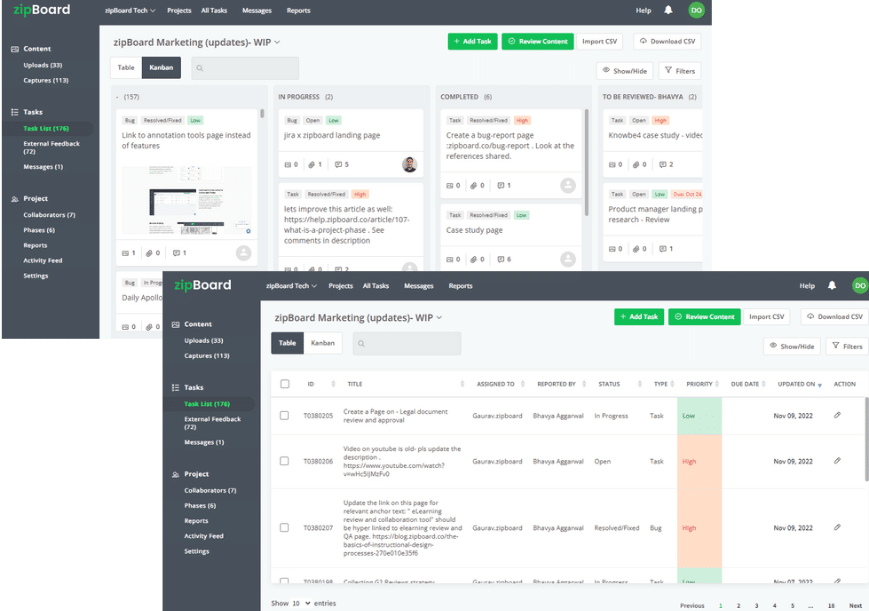
Efficient Task Management
Assign tasks to team members, set due dates, and mark priority levels. Stay organized and ensure that every feedback item gets addressed on time. Learn more about how to manage tasks in zipBoard here →
Templates for Faster Project Setup
Get projects up and running quickly with pre-built templates tailored to content review processes. Customize them as needed to fit your specific requirements.
Review Status Tracking & Audit Trail
Track the status of each review and maintain a clear audit trail. This feature helps keep accountability and ensures that no feedback is overlooked.
Guest Access—No Sign-Up Required
Invite external collaborators without requiring them to sign up. This feature makes client and stakeholder reviews seamless and hassle-free.
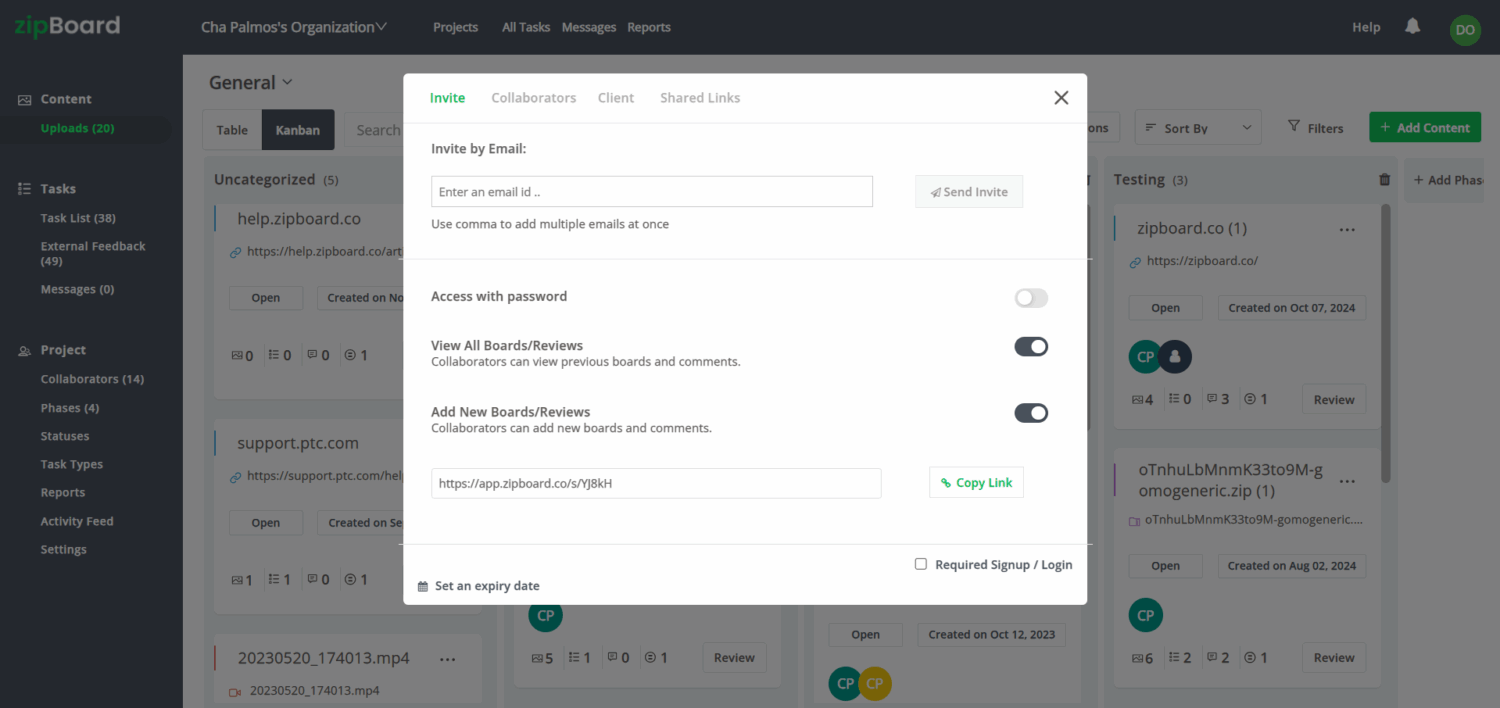
AI-Powered Features for Smarter Reviews
- Autogenerated Reports: Automatically generate comprehensive progress reports.
- Auto-Tagging: Automatically tag files and tasks for better organization and searchability.
- AI Review Assistant (Coming Soon): Detect grammar, spelling, and punctuation errors, suggest fixes, and turn feedback into actionable tasks.
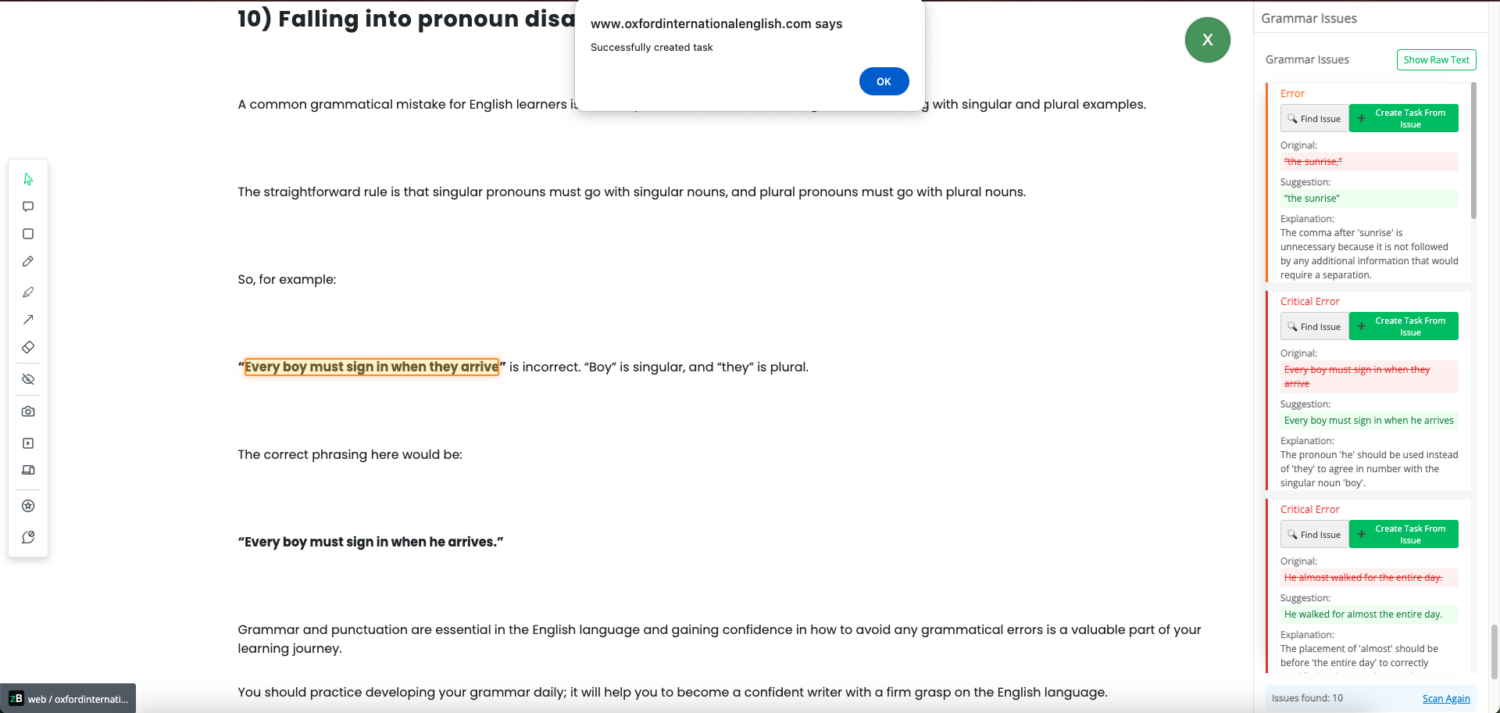
Multiple File Type Support
zipBoard supports a wide range of content, including web pages and apps (live URLs), images, PDFs, videos, SCORM files, and audio files, making it versatile for various industries.
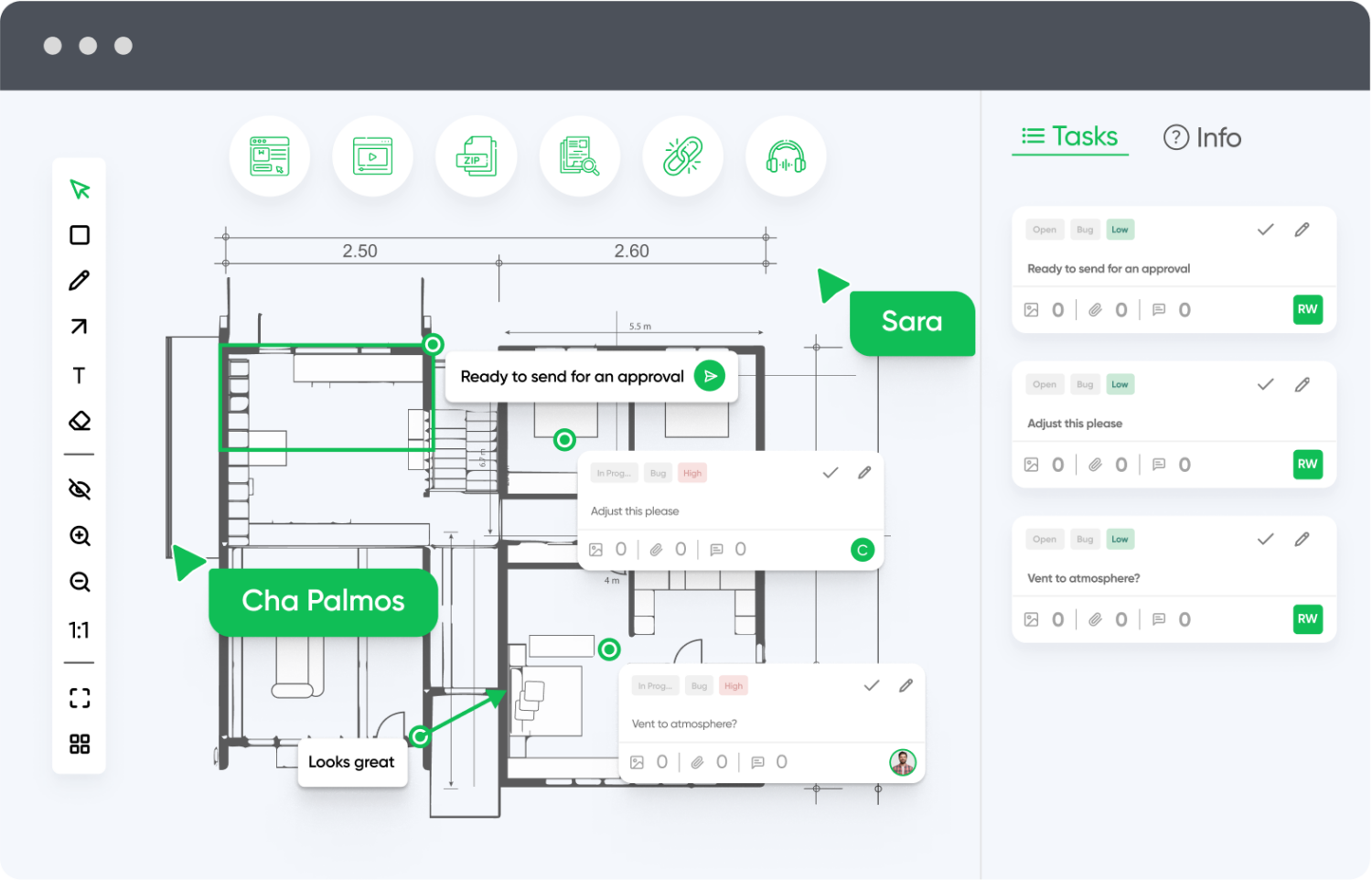
Integrations to Streamline Your Workflows
- Seamless Integrations: Connect with Jira, Slack, Microsoft Teams, Outlook, Wrike, Lambda Test, and more for smooth collaboration and project management.
- Custom Automation with APIs & Zapier: Automate workflows by connecting with your existing tools.
Why Teams Choose zipBoard
Teams prefer zipBoard for its affordability, flexibility, and scalability, making it a practical choice for both small businesses and large enterprises.
Rather than write up a small book I can quickly use the provided tools to visually capture the problem and point, encircle, and write a note connected to the needed changes. It has saved us so much time and increased productivity. Highly recommend.
– Nathan Williams, Marketing Director, Best Practice Medicine
Experience seamless content collaboration with zipBoard
Try it free for 14 days and see how much faster your team can move from feedback to final approval—even with external stakeholders. No credit card required.
Start Free TrialHow to Review Different Content Formats
- Text Content: Implement collaborative editing with comment threads for specific, actionable feedback. Track changes and maintain version history to identify and understand content revisions easily.
- Visual Content: Apply annotation tools to deliver clear, contextual feedback directly on images, designs, and layouts. Follow established design feedback principles to ensure visual consistency and quality standards.
- Video Content: Provide frame-specific comments for precise feedback on visual elements. Use timestamp references to direct reviewers to exact moments requiring attention or modification.
- Interactive Content: Perform thorough user flow testing to guarantee a seamless experience. Evaluate functionality and offer specific feedback on interactive elements such as buttons, quizzes, and navigation paths.
- Multi-Channel Content: Ensure consistency across all formats—text, visual, video, and interactive—by implementing standardized review guidelines and utilizing zipBoard’s unified review platform for centralized feedback management.
Need a single content approval software for all your content types?
Try zipBoard's versatile review platform and handle text, visual, video, and interactive content reviews in one unified workspace.
Book DemoStart Free TrialAutomating the Content Review and Approval Process
Why Automation Matters
Automating various aspects of the content review and approval process ensures team efficiency and project quality. Here’s why automation is crucial:
- Reduces Manual Coordination and Repetitive Tasks: Automation eliminates the need for constant follow-ups and manual tracking, ensuring that feedback is collected and processed without hassle.
- Minimizes Delays and Human Error: Automated workflows ensure that content moves through review phases without bottlenecks, and automatic notifications prevent important feedback from being missed.
- Improves Visibility Across Stakeholders: With automated status tracking, everyone involved in the review process can see progress at a glance, maintaining transparency.
- Ensures Content Reviews Stay on Track: Set automated reminders for reviewers and get instant updates on feedback status. This keeps the process moving without the need for manual intervention.
- Frees Up Team Time for Strategy and Creativity: By handling repetitive tasks automatically, your team can focus on creating high-quality content rather than managing the review process.
Ways to Automate the Review and Approval Workflow
- Workflow Automation Tools: Automatically route content to the right reviewers based on tags, project phase, or content type. This ensures that each piece of content is reviewed by the appropriate stakeholders without manual coordination.
- Automatic Reminders and Notifications: Never miss a review deadline. Set up automated reminders for reviewers and approvers, ensuring feedback is collected on time and the process stays on track.
- Version Control Systems: Prevent confusion caused by multiple drafts. Use version control to maintain a clear history of content changes, making it easy to track updates and revert if needed.
- Predefined Templates and Checklists: Save time by using templates for repeatable content types like product pages, policy documents, and marketing emails. Checklists ensure nothing is missed during reviews
- Auto-Approvals or Escalations: Set up rules for auto-approvals or escalation if no action is taken within a set deadline. This keeps content moving without unnecessary delays.
- AI/ML for Smart Recommendations: Leverage AI to suggest reviewers, highlight missing elements in content, or tag files automatically. This speeds up setup and reduces manual effort.
- Audit Trails for Accountability: Maintain a clear record of who reviewed or approved content, along with timestamps. This ensures transparency and accountability in the review process.
How zipBoard Helps Automate Content Review and Approval
1. AI-Powered Auto-Tagging for Files and Tasks
zipBoard automatically categorizes files and tasks with AI-powered tagging. This means your content is always organized, making it easier to filter and manage.
2. Automated Notifications and Review Status Tracking
Stay on top of the review process without manual follow-ups. zipBoard automatically notifies reviewers of pending tasks and tracks review status, ensuring no feedback is missed.
3. Pre-Built Templates for Project Setup and Workflows
Quickly set up review projects using predefined templates. Whether you’re reviewing web content, design assets, or videos, zipBoard has templates to fit your needs, saving time on setup.
4. Auto-Generated Reports for Internal and Client Updates
Generate comprehensive reports with a single click, providing clear updates on review progress, feedback received, and task completion. These reports can be shared with internal teams or clients for transparency.
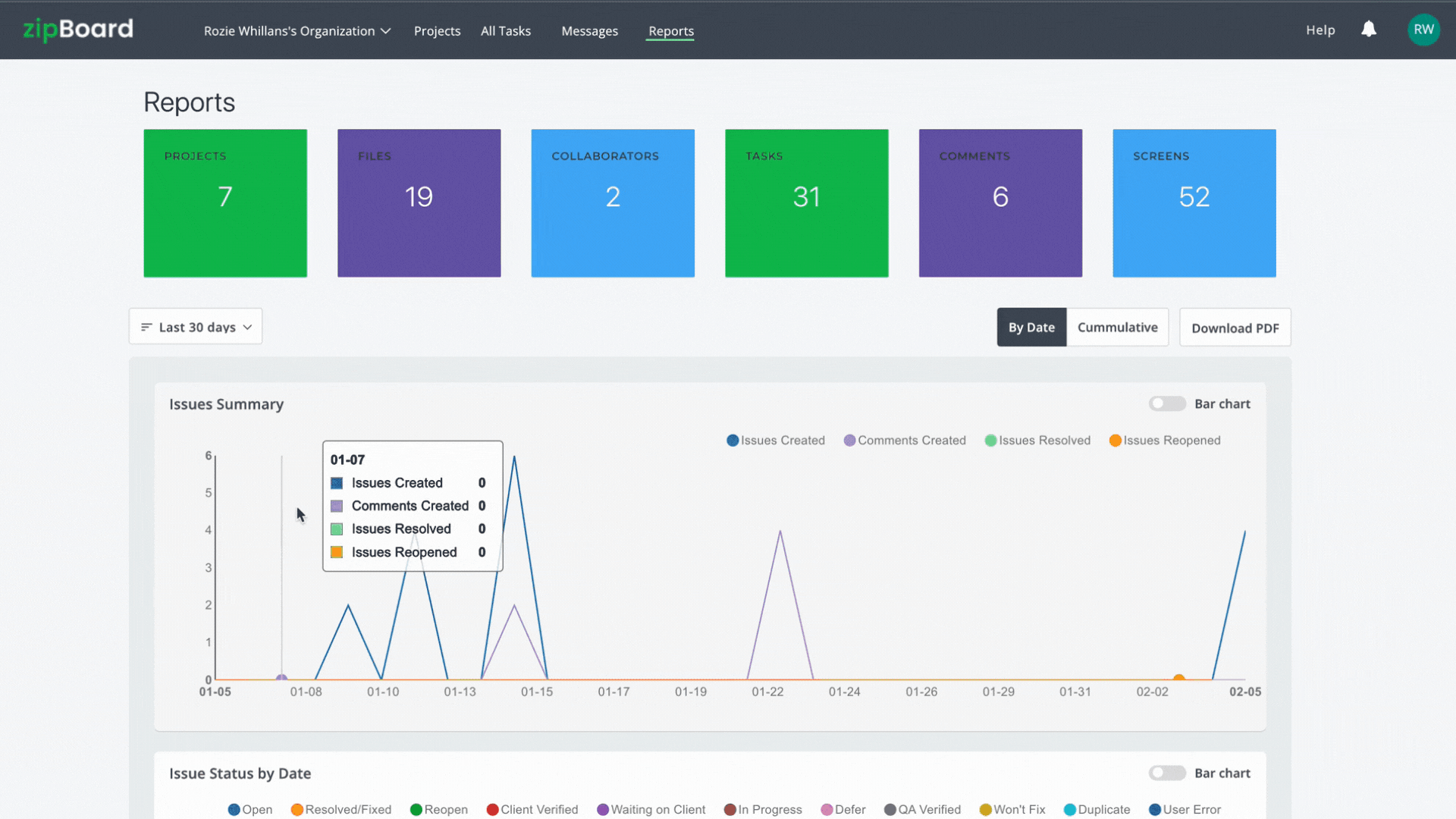
5. AI Review Assistant (Coming Soon)
Get AI-powered assistance to summarize feedback, identify key insights, and even suggest next steps for reviewers. This will further streamline the review process and ensure nothing is overlooked.

Want to see zipBoard's automation features in action?
Book a live demo with our team.
Book DemoStart Free TrialMeasuring the Effectiveness of Your Review Process
1. Key Metrics to Track
- Time to Approval: Measure the average time it takes for content to move from submission to final approval.
- Revision Cycles: Track the number of revisions a piece of content goes through before final approval. Fewer cycles often indicate clearer feedback and efficient review processes.
- Stakeholder Satisfaction: Collect feedback from reviewers and approvers to gauge their experience with the process, identifying pain points or areas for improvement.
2. Setting Baselines and Improvement Goals
- Establish your current performance metrics (e.g., average approval time, number of review cycles) as baselines.
- Set clear improvement goals, such as reducing review time by 20% or minimizing feedback misunderstandings.
3. Tools for Monitoring Review Process Efficiency
- Use zipBoard’s automated reports to track review progress and identify bottlenecks.
- Leverage dashboards for a clear view of review timelines, task completion rates, and reviewer engagement.
4. Regular Process Audits and Optimization
- Conduct periodic reviews of your content review process.
- Identify inefficiencies, such as unclear feedback or repetitive tasks, and adjust workflows for continuous improvement.
Final Thoughts
Streamlining your content review and approval process is essential for maintaining quality, meeting deadlines, and ensuring stakeholder satisfaction. Clear workflows, real-time collaboration, and automation are key to achieving this.
With the right content review tools and best practices, your team can navigate complex reviews more efficiently, keeping projects on track and stakeholders satisfied.
Ready to Streamline Content Collaboration with Clients, SMEs, and External Stakeholders?
Start your free trial of zipBoard today — no credit card needed. Or download our free Content Review Process Template to get started immediately.
Book DemoStart Free TrialFAQ: Content Review and Approval
A structured workflow where content is reviewed for feedback, revised, and then formally approved for use or publication.
Review involves gathering feedback and making changes; approval is the final confirmation that content is ready for use.
It reduces delays, minimizes errors, ensures accountability, and accelerates content delivery.
Text documents, images, videos, web pages, design files, and training materials.
Miscommunication, version control issues, slow feedback collection, and managing multiple stakeholders.
Clear roles, feedback guidelines, timelines, and escalation procedures.
Use a centralized platform to collect feedback in one place, define reviewer roles, and set clear deadlines.
Annotation tools, workflow automation, version control, task management, guest access, and reporting.
Yes, it can automate tagging, suggest improvements, and generate reports, saving time.
Track metrics like time to approval, number of revision cycles, and stakeholder satisfaction.
Author’s bio:
Dorcas Kpabitey is a Content Marketing Specialist at zipBoard. She began her content marketing journey alongside her BA in Political Science and Spanish at the University of Ghana. If she’s not tapping away at her keyboard or spending time on Twitter and LinkedIn, she spends her day reading articles, newsletters and books.
Recent Posts
- MEP Document Management: How to Streamline Reviews & Avoid Rework October 3, 2025
- What Is Online Proofing Software? And Why Content Review Breaks Without It July 11, 2025
- How Laerdal Medical Cut eLearning Review Time by 50% with zipBoard’s Visual Review Tool July 9, 2025
- Why Your Team Needs a Content Feedback System (Not Just Comments in Docs) May 28, 2025
- Content Approvals Are Slowing You Down — Here’s the Fix May 26, 2025
©️ Copyright 2023 zipBoard Tech. All rights reserved.

